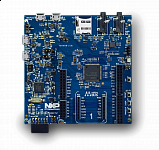LPCXpresso55S69

-
Core
Cortex-M33
-
Device
LPC55S69JBD100 -
CMSIS Pack
LPCXpresso55S69_BSP
-
erpc_matrix_multiply_rpmsg_rtos_cm33_core1
µVision AC6The Multicore eRPC Matrix Multiply RTOS project is a simple demonstration program that uses theMCUXpresso SDK software and the Multicore SDK to show how to implement the Remote Procedure Callbetween cores of the multicore system. The primary core (eRPC client) releases the secondary core(eRPC server) from the reset and then the erpcMatrixMultiply() eRPC call is issued to let thesecondary core to perform the multiplication of two randomly generated matrices. The originalmatrices and the result matrix is printed out to the serial console by the primary core. Thematrix multiplication can be issued repeatedly when pressing a SW board button. RPMsg-Lite erpctransport layer is used in this example application.Shared memory usageThis multicore example uses the shared memory for data exchange. The shared memory region isdefined and the size can be adjustable in the linker file. The shared memory region start addressand the size have to be defined in linker file for each core equally. The shared memory startaddress is then exported from the linker to the application.eRPC documentationeRPC specific files are stored in: middleware/multicore_<version>/erpceRPC documentation is stored in: middleware/multicore_<version>/erpc/doceRPC is open-source project stored on github: https://github.com/EmbeddedRPC/erpceRPC documentation can be also found in: http://embeddedrpc.github.io
Download Pack -
erpc_two_way_rpc_rpmsg_rtos_cm33_core0
µVision AC6The Multicore eRPC Two Way RPC RTOS project is a simple demonstration program that uses the MCUXpresso SDK software and the Multicore SDK to show how to implement the Remote Procedure Call between cores of the multicore system. This multicore example shows how both the eRPC client and the eRPC server can be setup on one side/core (bidirectional communication) and how to handle callback functions in eRPC. The primary core (Core0) creates client and server tasks first. The client task releases the secondary core from the reset, initializes the RPMsg-Lite erpc transport and once the server task is running it configures the arbitrated client. Then the application logic is running. The secondary core (Core1) creates client and server tasks two. The client task initializes the RPMsg-Lite erpc transport and once the server task is running it configures the arbitrated client. Then the application logic is running. The client task logic of the Core1 is very simple, it repeatedly calls the increaseNumber() erpc function that is implemented on the Core0 and that increments the counter. The client task logic of the Core0 alternately issues either getNumberFromCore0() function implementation on the Core0 or getNumberFromCore1() function implementation on the Core1 (erpc call). Then, the nestedCallGetNumber() erpc function call is issued that alternately triggers either getNumberFromCore1() function implementation on the Core1 (normal erpc call) or it triggers the getNumberFromCore0() function implementation on the Core0 (nested erpc call, routed through the Core1 erpc server).
Download Pack -
erpc_two_way_rpc_rpmsg_rtos_cm33_core1
µVision AC6The Multicore eRPC Two Way RPC RTOS project is a simple demonstration program that uses the MCUXpresso SDK software and the Multicore SDK to show how to implement the Remote Procedure Call between cores of the multicore system. This multicore example shows how both the eRPC client and the eRPC server can be setup on one side/core (bidirectional communication) and how to handle callback functions in eRPC. The primary core (Core0) creates client and server tasks first. The client task releases the secondary core from the reset, initializes the RPMsg-Lite erpc transport and once the server task is running it configures the arbitrated client. Then the application logic is running. The secondary core (Core1) creates client and server tasks two. The client task initializes the RPMsg-Lite erpc transport and once the server task is running it configures the arbitrated client. Then the application logic is running. The client task logic of the Core1 is very simple, it repeatedly calls the increaseNumber() erpc function that is implemented on the Core0 and that increments the counter. The client task logic of the Core0 alternately issues either getNumberFromCore0() function implementation on the Core0 or getNumberFromCore1() function implementation on the Core1 (erpc call). Then, the nestedCallGetNumber() erpc function call is issued that alternately triggers either getNumberFromCore1() function implementation on the Core1 (normal erpc call) or it triggers the getNumberFromCore0() function implementation on the Core0 (nested erpc call, routed through the Core1 erpc server).
Download Pack -
ethernet_over_usb
µVision AC6The Ethernet Over USB example.
Download Pack -
ethernet_over_usb
Keil Studio AC6, IARThe Ethernet Over USB example.
Download Pack -
filex_levelx_spiflash
µVision AC6The filex_levelx_spiflash example.
Download Pack -
filex_levelx_spiflash
Keil Studio AC6, IARThe filex_levelx_spiflash example.
Download Pack -
filex_ram_disk
µVision AC6The filex_ram_disk example.
Download Pack -
filex_ram_disk
Keil Studio AC6, IARThe filex_ram_disk example.
Download Pack -
filex_sdcard
Keil Studio AC6, IARThe filex_sdcard example.
Download Pack
